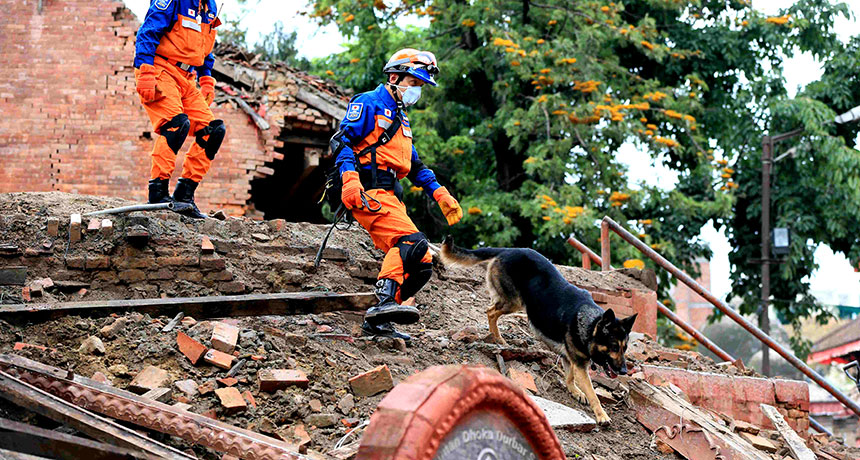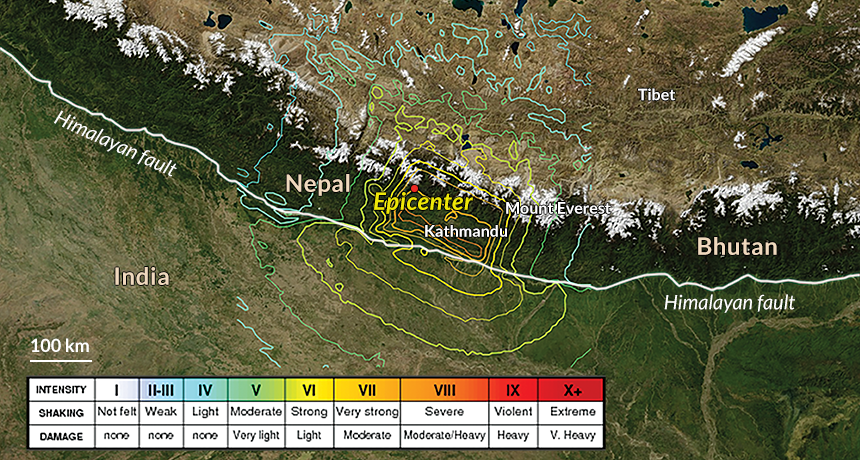
SHAKE DOWN A magnitude 7.8 earthquake struck April 25 northwest of Nepal’s capital city, Kathmandu. Scientists worry that other segments of the seismic fault could produce even more powerful quakes.
Yomiuri Shimbun/Associated Press
- More than 2 years ago
The April 25 earthquake that devastated Nepal, killing thousands, isn’t the end of seismic hazards in the region. The magnitude 7.8 earthquake relieved pent-up stress along just one segment of the tectonic plate boundary between India and the rest of Asia. Even larger quakes could strike to the west and in nearby Bhutan to the east, scientists warn.
Where and how intensely future earthquakes will strike depends in part on the shape of the seismic fault responsible for the Nepal quake, something that researchers don’t yet fully understand. But new research in the Himalayas has provided some glimpses into the hidden geology that controls seismic activity across the region. This work suggests that some areas could be even more at risk of strong quakes than previously thought.
“The hazard isn’t gone,” says geologist Kristin Morell of the University of Victoria in Canada. “The Himalayas are a very long mountain belt, and strain is still building up in all the other regions from Pakistan all the way to eastern Tibet.”
For around 50 million years, the Indian tectonic plate has been slipping under the Eurasian Plate at a rate of about 15 to 20 millimeters each year. This encounter doesn’t always go smoothly. The Indian plate dives downward at different angles along various parts of the boundary, from almost level to more than 30 degrees. Steeper angles increase friction between the plates, accumulating energy for centuries that rapidly releases in a matter of seconds in an earthquake. The recent Nepal earthquake’s epicenter was along one of these strongly sloping sections.
But when an earthquake hits, it doesn’t strike along the full fault. Scientists believe this is because of physical barriers along the fault, such as locations where the angle between the two plates changes quickly. An earthquake triggered on one side of a barrier won’t hop over the boundary and spread farther along the fault. The larger an uninterrupted segment, the more powerful the earthquakes it can produce.
Story continues after map

By looking at the surface, Morell and colleagues discerned the structure of part of the fault west of where the recent Nepal earthquake struck. The area included a spot where the angle between the plates rapidly steepened. A magnitude 8 or greater quake could happen on either side of this transition, the researchers report online March 12 in Lithosphere.
Employing a similar technique farther east along the fault in Bhutan, a separate research team uncovered a wide segment of the fault without any potential boundaries. This large segment has the potential to produce even larger earthquakes than previously expected, the researchers report in a paper to be published in Geophysical Research Letters. “If there is a big earthquake in Bhutan, it could be larger than the recent earthquake in Nepal,” says coauthor Rodolphe Cattin, a geophysicist at the University of Montpellier in France.
The fault could be prepped for a big quake to the west of the Nepal quake’s epicenter as well, says geophysicist Simon Klemperer of Stanford University. The at-risk fault segment in western Nepal is at least twice as long as the one that recently rattled the country’s eastern side and has been building stress since its last major quake in 1505. “The earthquake I worry about is not the one that happened on [April 25]; it’s the one that could be a magnitude 8.6 to the west.”






